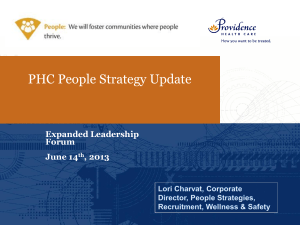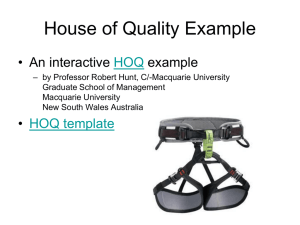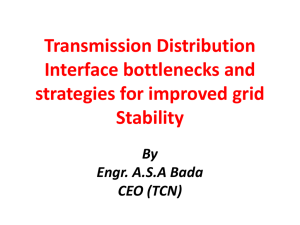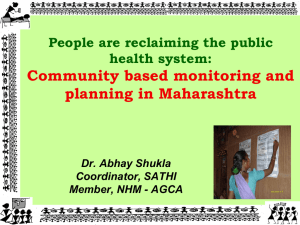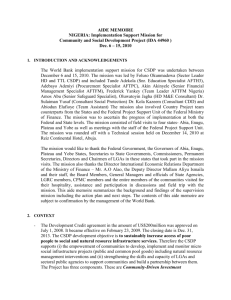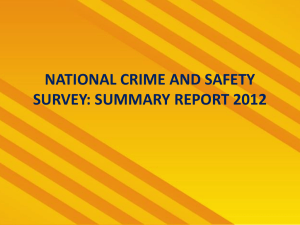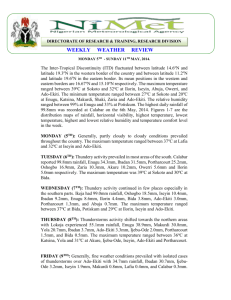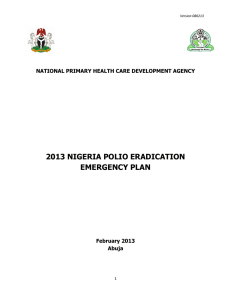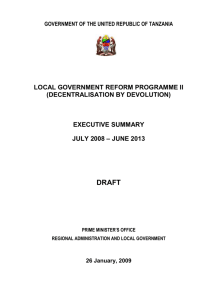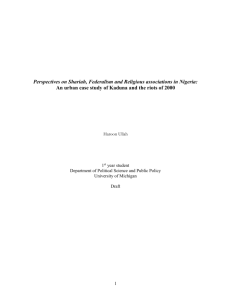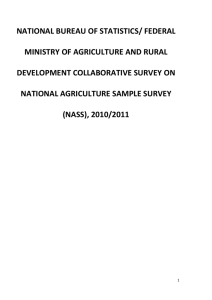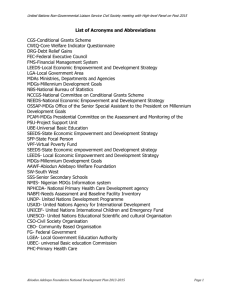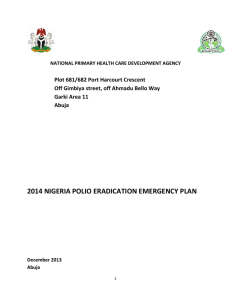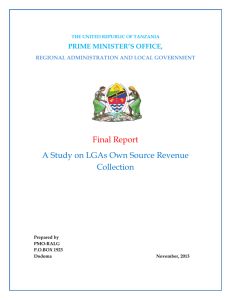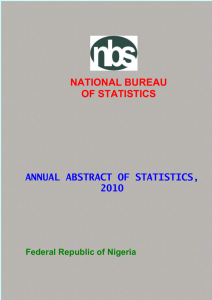Overall framework, indicators, and methodologies
advertisement
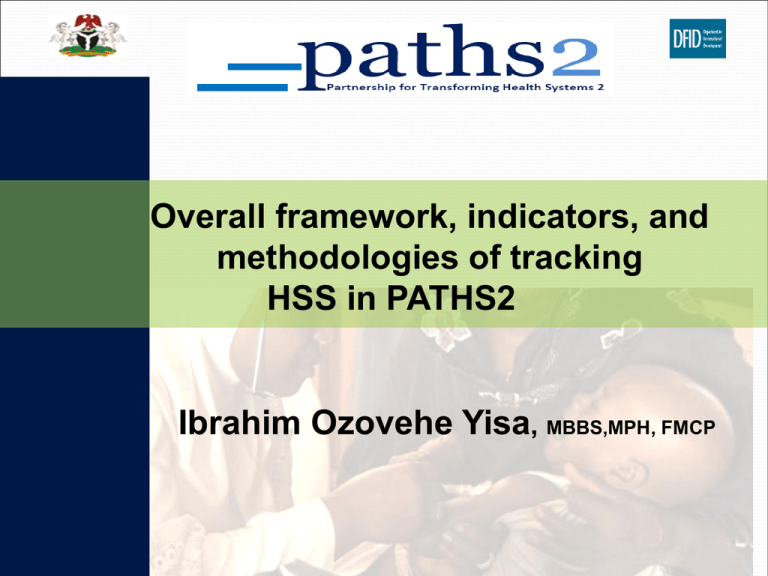
Overall framework, indicators, and methodologies of tracking HSS in PATHS2 Ibrahim Ozovehe Yisa, MBBS,MPH, FMCP Outline of the Presentation Nigeria: Background and context PATHS2 Programme Measuring and tracking progress Logframe Baselines Background & Context (I) • State of Nigerian Health System: • Poor performance • Ranked 187 out of 192 health systems assessed (WHO, 2000) • Factors responsible for poor performance are multidimensional, but can be broadly grouped into: • Fragmentation of the health system characterized by : • Inability of government to provide effective leadership & strategic direction in the health sector • poor coordination /linkage between multiple actors, including engagement with the community and the private sector Background & Context (II) Failures of system components characterized by: • Decay of health infrastructure • Dysfunctional HMIS • Dysfunctional & uncoordinated supply of health commodity and distribution system • Critically low level of health workforce • Inadequate funding GOAL Nigeria's own resources are efficiently and effectively used to achieve the MDGS PURPOSE: To improve the planning, financing and delivery of sustainable and replicable pro-poor services for common health problems in up to 6 states Output 1 Output 2 Output 3 Output 4 Output 5 STEWARDSHIP STATE SYSTEMS SERVICES and SUPPLIES VOICE and ACCOUNTABILITY Informed citizens POLICY AND PLANNING CAPACITY DEVELOPMENT KNOWLEDGE MANAGEMENT MONITORING AND EVALUATION PARTNERSHIPS AND CO-ORDINATION 4/13/2015 OPERATIONS RESEARCH 5 4/13/2015 6 PATHS2 M&E Strategy for measuring HSS • Covers the health system approach & all five PATHS2 outputs Output 1: Governance (Stewardship): • Capability • Accountability (PEMR) • Responsiveness Output 2: State systems: • HF, HRH, HMIS, availability of health commodities & distribution system Output 3: Service Delivery (sustainable, replicable & pro-poor) • Availability, utilization, quality of care & level of satisfaction Output 4: Community engagement (CSM) Output 5: Informed citizens (Ask Nig Project) • Total of 27 indicators Baseline survey General Objective: Specific Objectives: To determine the situation of Health Care Service delivery in PATHS2 Supported States in Nigeria To examine the status of selected supplyand demand-side health system factors affecting service delivery 4/13/2015 To examine the current status of service availability and use in PHC facilities To update the baseline information for the PATHS2 logframe for monitoring and evaluating the progress of the programme 8 Study Design & Methodology Nigerian healthcare delivery system is structured into: PHC at LGA level (District), SHC (State level) & Tertiary (Fed) All LGAs in the supported states were included in the survey Availability and use of services at PHC, central focus of the study Sampling frame - List of PHC facilities & catchment areas in an LGA - (does not exist in the Nigerian Statistical Structure) Design Option: Enumeration Areas (EAs) provided by NPC & NBS used as sampling frame and nearest HF captured Two EAs randomly selected from each LGA Sixteen (16) HHs randomly selected from 250 EAs Total of 4000 HHs randomly selected for the study (Sample size) Baseline survey instruments 1. Household survey (HHS) 2. Facility survey (FS) 3. Policy assessment tool (PA) 4. Federal-level data collection tool (F) 5. State-level data collection tool (ST) 6. LGA-level data collection tool (LGA) 7. Health information & Communication (HC) 9. Qualitative data collection instruments for addressing issues on community engagement 4/13/2015 10 PATHS2 27 Logframe Indicators & Baseline Values Level Name of Indicator Baseline Value Goal: 1 Goal: 2 Under 5 Mortality Rate Proportion of births attended by skilled health personnel Goal: 3 TB Case Detection Rate 157 deaths per 1000 live births National: 38.9%; Enugu, 65.5%: Jigawa 5.1%; Kaduna, 21.8%; Kano, 12.7% National: 30.5%; Enugu, 45.5%; Jigawa, 23.3%; Kaduna, 65.9%; Kano, 58.7% National: 10% Purpose: 1 Level of compliance with the MTSS process in the preparation of annual performance based budgeting at federal and state levels Purpose: 2 Antenatal Care Coverage (4 Visits) National: 44.8%; Urban, 68.8%; Rural, 34.4% Purpose: 3 Proportion of 1 Year old children immunized against National: 41.4%; Enugu, 53.6%; measles Jigawa,8.3%; Kaduna, 56.9%; Kano, 17.8% Purpose: 4 Percentage of LGAs in PATHS2 Supported states To be determined with at least one functioning pro-poor health financing mechanism (safety nets) Purpose: 5 Number of states implementing systems 0 strengthening approaches to increase access to quality services for women and the poorest Output:1.1 Number of new and revised federal policies, plans, and legislation developed with PATHS2 support are consistent with National Strategic Health Development Plan (NSHDP) and meet a minimum quality standard 0 Output:1.2 Level of compliance with NHA institutionalization process 20% Output:1.3 Number of federal agencies with institutional capacity for HMIS 0% Output:2.1 Number of new and revised state policies, plans, and legislation developed with PATHS2 support are consistent with National Strategic Health Development Plan (NSHDP) and meet a minimum quality standard 0% Output:2.2 Percentage of budgeted State & LGA funds for health being disbursed To be determined from public expenditure review Output:2.3 Percentage of health facilities submitting timely and complete HMIS reports To be determined Output:2.4 Number of states with adequate institutional capacity for human resource planning 0% Output: 3.1 Percentage of health facilities in PATHS2 supported states with essential drugs consistently available All 4 States: PHC, 4.9%; SHC, 18.5%; Enugu, PHC, 0.0%, SHC,0.0; Jigawa, PHC, 3.8%; SHC, 0.0% ; Kaduna, PHC, 8.5%; SHC, 0.0; Kano, PHC, 6.0%; 35.7% Output: 3.2 Percentage of health facilities in PATHS2 supported states providing basic emergency obstetric care services All 4 States: 4.5%; Enugu, 0.0%; Jigawa, 12.5%; Kaduna, 3.3%; Kano, 13.3% Output: 3.3 Percentage of clients in PATHS2 supported states re-porting satisfaction with primary health care services All 4 states: 29.1%; Enugu,32.4%; Jigawa, 30.5%; Kaduna, 33.8%; Kano,24.3% Output: 3.4 Number of communities in PATHS2 supported LGAs with effective mechanisms to overcome socio-cultural and/or financial barriers to access emergency obstetric care TBD Output: 4.1 Percentage of advocacy objectives achieved by PATHS2 supported issue based coalitions 12% Output: 4.2 Percentage of functioning facilities within PATHS2 supported LGAs with functioning systems for enforcing health entitlements 0% Output: 4.3 Percentage of advocacy objectives achieved by PATHS2 supported issue based coalitions 0% Output: 4.4 Percentage of functioning facilities within PATHS2 supported LGAs with functioning systems for enforcing health entitlements 0% Output: 5.1 Percentage of people in PATHS2 supported LGAs who have heard of and/or participated in public dialogue on public health issues Enugu: 13.6% Jigawa: 12.5% Kaduna: 16.5% Kano: 12.0% Output: 5.2 Number of people in PATHS2 supported LGAs who participated in public health dialogue events with good re-call of public health issues To be determined Output: 5.3 Percentage of people in PATHS2 supported LGAs who have adequate knowledge on the signs and prevention of common health conditions Overall, 2.9%; Enugu, 0.0%; Jigawa, 3.1%; Kaduna, 11.1%; Kano, 9.8% Output: 5.4 Percentage of people in PATHS2 supported LGAs who can correctly identify health service entitlements Overall, 10.0%; Enugu, 16.2%; Jigawa, 8.3%; Kaduna, 10.1%; Kano: 8.5% Thank you



